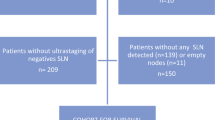Abstract
Purpose
Surgical staging in endometrial cancer has evolved and sentinel lymph node (SLN) mapping has replaced a full pelvic and paraaortic lymphadenectomy in several cases. An intraoperative evaluation of SLN might identify patients who could benefit the most from a full lymphadenectomy. The aim of this study is to evaluate the clinical relevance of frozen section of SLN.
Methods
A retrospective analysis in patients with endometrial cancer who underwent SLN mapping with intraoperative evaluation at frozen section between February 2016 and September 2019 was performed. In case of metastatic involvement, a full lymphadenectomy was performed.
Results
Fifty-eight patients met the inclusion criteria. Clinical–pathologic characteristics of the patients and surgical data were analyzed. Overall, bilateral and unilateral detection rates were 100% (58/58), 89.7% (52/58), and 10.3% (6/58), respectively. Eight patients had a stage IIIC disease at permanent section. Frozen section detected SLN metastases in four of eight patients. Of these, two were micrometastases and two were macrometastases. At frozen section of the SLNs, no macrometastases were misdiagnosed. Sensitivity, specificity, accuracy, positive predictive value and negative predictive value of frozen section in detecting metastases was 50%, 100%, 93%, 100% and 92.6%, respectively.
Conclusion
The intraoperative evaluation of SLN in endometrial cancer accurately identifies patients with macrometastases. This is the cohort that might benefit the most of a full lymphadenectomy for a higher risk of additional lymph node metastases.

Similar content being viewed by others
References
Alhilli MM, Mariani A (2013) The role of paraaortic lymphadenectomy in endometrial cancer. Int J Clin Oncol 18:193–199
ASTEC study group, Kitchener H, Swart AM et al (2009) Efficacy of systematic pelvic lymphadenectomy in endometrial cancer (MRC ASTEC trial): a randomized study. Lancet 373:125–136
Barlin JN, Khoury-Collado F, Kim CH et al (2012) The importance of applying a sentinel lymph node mapping algorithm in endometrial cancer staging: beyond removal of blue nodes. Gynecol Oncol 125:531–535
Benedetti Panici P, Basile S, Maneschi F et al (2008) Systematic pelvic lymphadenectomy vs no lymphadenectomy in early-stage endometrial carcinoma: randomized clinical trial. J Natl Cancer Inst 100:1707–1716
Bogani G, Casarin J, Roberti Maggiore UL et al (2020) Survival outcomes in endometrial cancer patients having lymphadenectomy, sentinel node mapping followed by lymphadectomy and sentinel node mapping alone: Long-term results of a propensity-matched analysis. Gynecol Oncol 158(1):77–83
Bogani G, Dowdy SC, Cliby WA et al (2014) Role of pelvic and paraaortic lymphadenectomy in endometrial cancer: current evidence. J Obstet Gynecol Res 40:301–311
Buda A, Gasparri ML, Puppo A et al (2018) Lymph node evaluation in high-risk early stage endometrial cancer: a multi-institutional retrospective analysis comparing the sentinel lymph-node (SLN) algorithm and SLN with selective lymphadenectomy. Gynecol Oncol 150(2):261–266
Buda A, Papadia A, Zapardiel I et al (2016) From Conventional Radiotracer Tc-99(m) with blue dye to indocyanine green fluorescence: a comparison of methods towards optimization of sentinel lymph node mapping in early stage cervical cancer for a laparoscopic approach. Ann Surg Oncol 23:2959–2965
Colombo N, Creutzberg C, Amant F et al (2016) ESMO-ESGO-ESTRO Consensus Conference on Endometrial Cancer diagnosis treatment and follow-up. Ann Oncol 27:16–416
Cormier B, Diaz JP, Shih K et al (2011) Establishing a sentinel lymph node mapping algorithm for the treatment of early cervical cancer. Gynecol Oncol 122:275–280
Creasman W (2009) Revised FIGO staging for carcinoma of the endometrium. Int J Gynecol Obstet 105:109
Creasman WT, Morrow CP, Bundy BN et al (1987) Surgical pathological spread patterns of endometrial cancer. Gynecol Oncol Group Study Cancer 60:2035–2041
De Boer MS, Powell M, Mileshkin L et al (2019) Adjuvant chemoradiotherapy versus radiotherapy alone in women with high-risk endometrial cancer (PORTEC-3): patterns of recurrence and post-hoc survival analysis of a randomized phase 3 trial. Lancet Oncol 20:1273–1285
Ditto A, Martinelli F, Bogani G et al (2015) Sentinel node apping using hysteroscopic injection of indocynine green and laparoscopic near-infrared fluorescence imaging in endometrial cancer staging. JMIG 22:132–133
Emons G, Tempfer C, Battista MJ et al (2018) Statement of the Uterus Committee of the Gyneclogical Oncology Working Grup (AGO) on the Portec-3 study. Geburtshilfe Frauenheilkd 78(10):923–926
Fanfani F, Monterossi G, Ghizzoni V et al (2018) One-Step Nucleic Acid Amplification (OSNA): A fast molecular test based onCK19 mRNA concentration for assessment of lymph-nodes metastases in early stage endometrial cancer. PLoS ONE 26:13
Gasparri ML, Caserta D, Panici PB et al (2019) Surgical staging in endometrial cancer. J Cancer Res Clin Oncol 145:213–221
Hollaway RW, Abu-Rustum NR, Backes FJ et al (2017) Sentinel lymph node mapping and staging in endometrial cancer: a society of gynecologic oncology literature review with consensus recommendations. Gynecol Oncol 146:405–415
Imboden S, Papadia A, Nauwerk M et al (2015) A comparison of radiocolloid and Indocyanine green fluorescence imaging, sentinel lymph node mapping in patients with cervical cancer undergoing laparoscopic surgery. Ann Surg Oncol 22:4198–4203
Kim CH, Slow RA, Park KJ et al (2013) Pathological ultrastaging improves micrometastasis detection in sentinel lymph nodes during endometrial cancer staging. Int J Gynecol Cancer 23:964–970
Kumar S, Podratz KC, Bakkum-Gamez JN et al (2014) Prospective assessment of the prevalence of pelvic, paraaortic and high paraaortic lymph node metastasis in endometrial cancer. Gynecol Oncol 132:38–43
Lambrou N, Gomez-Marin O, Mirhashemi R et al (2004) Optimal cytoreduction in patients with stage III and IV endometrial carcinoma: a study of morbidity and survival. Gynecol Oncol 93:653–658
Matei D, Filiaci VL, Randall M et al (2019) Adjuvant chemotherapy plus radiation for locally advanced endometrial cancer. NEJM 380:2317–2326
Monterossi G, Buca D, Dinoi G et al (2019) Intra-operative assessment of sentinel lymph node status by one-step nucleic acid amplification assay (OSNA) in early endometrial cancer: a prospective study. Int J Gynecol Cancer 29:1016–1020
Multinu F, Casarin J, Cappuccio S et al (2019) Ultrastaging of negative pelvic lymph nodes to decrease the true prevalence of isolated paraaortic dissemination in endometrial cancer. Gynecol Oncol 154:60–64
Ouldamer L, Bendifallah S, Body G et al (2017) Call for surgical nodal staging in women with ESMO/ESGO/ESTRO high-intermediate risk endometrial cancer: a multicenter cohort analysis from the FRANCOGYN study group. Ann Surg Oncol 24:1660–1666
Papadia A, Buda A, Gasparri ML et al (2018) The impact of different doses of indocyanine green on the sentinel lymph-node mapping in early stage endometrial cancer. J Cancer Res Clin Oncol 144:2187–2191
Papadia A, Imboden S, Gasparri ML et al (2016) Endometrial and cervical cancer patients with multiple sentinel lymph nodes at laparoscopic ICG mapping: how many are enough? J Cancer Res Clin Oncol 124:1831–1836
Papadia A, Morosi C, Wang J et al (2019) SLN mapping in early-stage cervical cancer as minimal-invasive training tool for multimodal treatment. Eur J Surg Oncol 45:679–683
Plante M, Stanleigh J, Renaud MC et al (2017) Isolated tumor cells identified by sentinel lymph node mapping in endometrialcancer: does adjuvant treatment matter? Gynecol Oncol 146:240–246
Renz M, Marjon N, Devereaux K et al (2020) Immediate intraoperative sentinel lymph node analysis by frozen section is predictive of lymph node metastasis in endometrial cancer. J Robot Surg 14:35–40
Rossi EC, Kowalski LD, Scalici J et al (2017) A comparison of sentinel lymph node biopsy to lymphadenectomy for endometrial cancer staging (FIRES trial): a multicenter, prospective cohort study. Lancet Oncol 18:384–392
Ruscito I, Gasparri ML, Braicu EI et al (2016) Sentinel node mapping in cervical and endometrial cancer: indocyanine green versus other conventional dyes – a meta analysis. Ann Surg Oncol 23:3749–3756
Tanner E et al (2017) Use of a novel sentinel lymph node mapping algorithm reduces the need for pelvic lymphadenectomy in low-grade endometrial cancer. Gynecol Oncol 147:535–540
Todo Y, Kato H, Kaneuchi M et al (2010) Survival effect of paraaortic lymphadenectomy in endometrial cancer (SEPAL study): a retrospective cohort analysis. Lancet 375:1165–1172
Touhami O, Grégoire J, Renaud MC et al (2017) Performance of sentinel lymph node (SLN) mapping in high-risk endometrialcancer. Gynecol Oncol 147:549–553
Turan T, Hizli D, Sarici S et al (2011) Is it possibile to predict para-aortic lymph node metastasis in endometrial cancer? Eur J Obstet Gynecol Reprod Biol 158:274–279
Funding
No external funding was obtained for the purpose of the research.
Author information
Authors and Affiliations
Contributions
SB: data curation, formal analysis, writing—original draft preparation, editing. MB: data curation, formal analysis, writing—original draft preparation. MLG: supervision, review. LC: data curation, Software. PM: resources. LM: resources. AP: conceptualization, project, review.
Corresponding author
Ethics declarations
Conflict of interest
The authors declare that they have no conflict of interest.
Ethics approval
The study was approved by ethics committee (2019-01376-CE 3506).
Consent for publication
Authors provide consent for publication.
Additional information
Publisher's Note
Springer Nature remains neutral with regard to jurisdictional claims in published maps and institutional affiliations.
Rights and permissions
About this article
Cite this article
Bellaminutti, S., Bonollo, M., Gasparri, M.L. et al. Sentinel lymph node intraoperative analysis in endometrial cancer . J Cancer Res Clin Oncol 146, 3199–3205 (2020). https://doi.org/10.1007/s00432-020-03356-x
Received:
Accepted:
Published:
Issue Date:
DOI: https://doi.org/10.1007/s00432-020-03356-x




